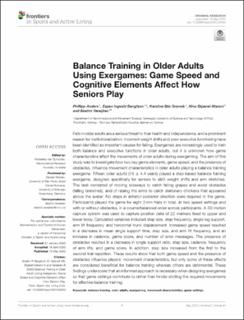| dc.description.abstract | Falls in older adults are a serious threat to their health and independence, and a prominent reason for institutionalization. Incorrect weight shifts and poor executive functioning have been identified as important causes for falling. Exergames are increasingly used to train both balance and executive functions in older adults, but it is unknown how game characteristics affect the movements of older adults during exergaming. The aim of this study was to investigate how two key game elements, game speed, and the presence of obstacles, influence movement characteristics in older adults playing a balance training exergame. Fifteen older adults (74 ± 4.4 years) played a step-based balance training exergame, designed specifically for seniors to elicit weight shifts and arm stretches. The task consisted of moving sideways to catch falling grapes and avoid obstacles (falling branches), and of raising the arms to catch stationary chickens that appeared above the avatar. No steps in anterior-posterior direction were required in the game. Participants played the game for eight 2 min trials in total, at two speed settings and with or without obstacles, in a counterbalanced order across participants. A 3D motion capture system was used to capture position data of 22 markers fixed to upper and lower body. Calculated variables included step size, step frequency, single leg support, arm lift frequency, and horizontal trunk displacement. Increased game speed resulted in a decrease in mean single support time, step size, and arm lift frequency, and an increase in cadence, game score, and number of error messages. The presence of obstacles resulted in a decrease in single support ratio, step size, cadence, frequency of arm lifts, and game score. In addition, step size increased from the first to the second trial repetition. These results show that both game speed and the presence of obstacles influence players’ movement characteristics, but only some of these effects are considered beneficial for balance training whereas others are detrimental. These findings underscore that an informed approach is necessary when designing exergames so that game settings contribut | en_US |
| dc.description.localcode | © 2020 Anders, Bengtson, Grønvik, Skjæret-Maroni and Vereijken. This is an open-access article distributed under the terms of the Creative Commons Attribution License (CC BY). The use, distribution or reproduction in other forums is permitted, provided the original author(s) and the copyright owner(s) are credited and that the original publication in this journal is cited, in accordance with accepted academic practice. No use, distribution or reproduction is permitted which does not comply with these terms. | en_US |

